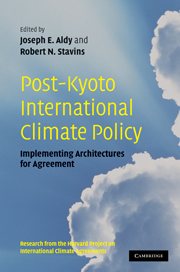Book contents
- Frontmatter
- Contents
- Harvard Environmental Economics Program, International Advisory Board
- Harvard Project on International Climate Agreements, Faculty Steering Committee
- Harvard Project on International Climate Agreements, Project Management
- List of figures
- List of tables
- List of contributors
- Foreword
- 1 Introduction
- Part I Alternative international policy architectures
- Part II Negotiation, assessment, and compliance
- Part III The role and means of technology transfer
- Part IV Global climate policy and international trade
- Part V Economic development, adaptation, and deforestation
- Part VI Modeling impacts of alternative allocations of responsibility
- Part VII Synthesis and conclusion
- Appendix A Selected List of Individuals Consulted, Harvard Project on International Climate Agreements
- Appendix B Workshops and Conferences, Harvard Project on International Climate Agreements
- Glossary and Abbreviations
- Index
1 - Introduction
Published online by Cambridge University Press: 05 June 2012
- Frontmatter
- Contents
- Harvard Environmental Economics Program, International Advisory Board
- Harvard Project on International Climate Agreements, Faculty Steering Committee
- Harvard Project on International Climate Agreements, Project Management
- List of figures
- List of tables
- List of contributors
- Foreword
- 1 Introduction
- Part I Alternative international policy architectures
- Part II Negotiation, assessment, and compliance
- Part III The role and means of technology transfer
- Part IV Global climate policy and international trade
- Part V Economic development, adaptation, and deforestation
- Part VI Modeling impacts of alternative allocations of responsibility
- Part VII Synthesis and conclusion
- Appendix A Selected List of Individuals Consulted, Harvard Project on International Climate Agreements
- Appendix B Workshops and Conferences, Harvard Project on International Climate Agreements
- Glossary and Abbreviations
- Index
Summary
Diverse aspects of human activity around the world result in greenhouse gas (GHG) emissions that contribute to global climate change. Emissions come from coal-fired power plants in the United States, diesel buses in Europe, rice paddies in Asia, and the burning of tropical forests in South America. These emissions will affect the global climate for generations, because most greenhouse gases reside in the atmosphere for decades to centuries. Thus, the impacts of global climate change pose serious, long-term risks.
Global climate change is the ultimate global-commons problem: Because GHGs mix uniformly in the upper atmosphere, damages are completely independent of the location of emissions sources. Thus, a multinational response is required. To address effectively the risks of climate change, efforts that engage most if not all countries will need to be undertaken. The greatest challenge lies in designing an international policy architecture that can guide such efforts. We take “international policy architecture” to refer to the basic nature and structure of an international agreement or other multilateral (or bilateral) climate regime.
The Kyoto Protocol to the United Nations Framework Convention on Climate Change (UNFCCC) marked the first meaningful attempt by the community of nations to curb GHG emissions. This agreement, though a significant first step, is not sufficient for the longer-term task ahead. Some observers support the policy approach embodied in Kyoto and would like to see it extended—perhaps with modifications—beyond the first commitment period, which ends in 2012. Others maintain that a fundamentally new approach is required.
- Type
- Chapter
- Information
- Post-Kyoto International Climate PolicyImplementing Architectures for Agreement, pp. 1 - 28Publisher: Cambridge University PressPrint publication year: 2009
- 1
- Cited by

